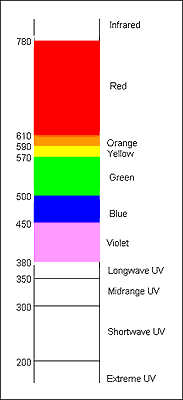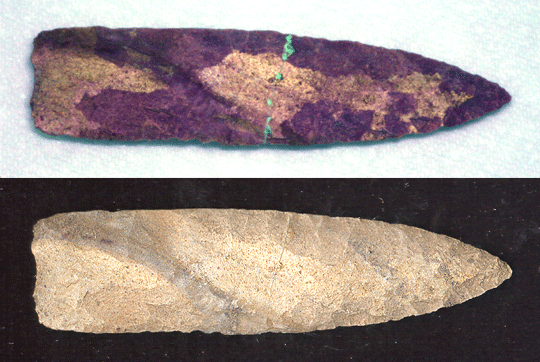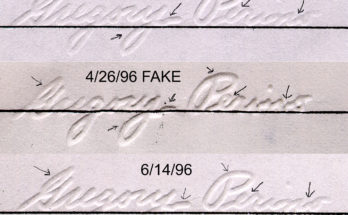By Alex Przygoda (Originally printed Arrowheads.com-Offline Magazine #3 2006)
 Ultraviolet Light: What is it really good for? Ultraviolet, also known as “Blacklight” has for years been used in determining the authenticity of artifacts. You might have overheard another collector commenting, ” I blacklighted it, and it looked ok!” What exactly did he see? Was he using the UV correctly? Did he get a false indication? This article aims to demystify the appropriate usage of Ultraviolet lights, some common misconceptions, explain the processes involved, and educate the collecting public to the history of lithic analysis with Ultraviolet light.What is Ultraviolet Light? Ultraviolet, or UV light, exists as electromagnetic radiation just beyond light visible to the human eye. It begins at 380 nanometers, and extends down to about 200 nanometers, to the point where extreme UV and microwave radiation exist. Ultraviolet light is broken down into 3 distinct groups, Longwave (UVA), Midrange (UVB), and Shortwave (UVC). Longwave UV exists between 380 and 350 nanometers. Most common “blacklights” are in fact Longwave UV lamps that also allow a little near-UV or violet light out, giving them their characteristic purple glow. Midrange UV is not commonly used. Shortwave UV lights require special quartz glass tubes and special filters to allow only shortwave transmission.
Ultraviolet Light: What is it really good for? Ultraviolet, also known as “Blacklight” has for years been used in determining the authenticity of artifacts. You might have overheard another collector commenting, ” I blacklighted it, and it looked ok!” What exactly did he see? Was he using the UV correctly? Did he get a false indication? This article aims to demystify the appropriate usage of Ultraviolet lights, some common misconceptions, explain the processes involved, and educate the collecting public to the history of lithic analysis with Ultraviolet light.What is Ultraviolet Light? Ultraviolet, or UV light, exists as electromagnetic radiation just beyond light visible to the human eye. It begins at 380 nanometers, and extends down to about 200 nanometers, to the point where extreme UV and microwave radiation exist. Ultraviolet light is broken down into 3 distinct groups, Longwave (UVA), Midrange (UVB), and Shortwave (UVC). Longwave UV exists between 380 and 350 nanometers. Most common “blacklights” are in fact Longwave UV lamps that also allow a little near-UV or violet light out, giving them their characteristic purple glow. Midrange UV is not commonly used. Shortwave UV lights require special quartz glass tubes and special filters to allow only shortwave transmission.
The fluorescence caused by Ultraviolet light contacting a reactive material is a form of luminescence, or ‘cold light’. In the case of fluorescence, the ultraviolet energy excites an electron in a low energy state to an unstable higher energy state. When the electron returns to its stable state, the energy is given off as light. Here is an analogy to help clarify..
If you lift a rock, your muscles are supplying energy to raise the rock to a higher-energy position. If you then drop the rock, the energy you supplied is released, some of it in the form of sound, as it drops back to its original low-energy position. It is somewhat the same with fluorescence, with electrical attraction replacing gravity, the atomic nucleus replacing the earth, an electron replacing the rock, and light replacing the sound.
What causes an artifact to fluoresce? Inside most lithic materials are chemical compounds called fluorophors. (Shockey, 1995) These fluorophors are the reactive components of the stone that fluoresce when subjects to UV radiation. These fluorophors are also in common everyday materials like laundry detergent, certain inks, paper, plastics, and even flowers and animal materials.
Up ’til now you might be thinking, “So what’s the bottom line! Get to the point already!!”
When an artifact is made, freshly exposed fluorophors find themselves on the surface and exposed to the elements of nature. Over time, some or all of these fluorophors erode away, or are converted into different kinds of fluorophors, leaving either a non-fluorescent surface or a fluorescent surface that was created with time, much like a ‘patina’ or oxidation rind commonly seen on many types of artifacts. When this surface is broken into, fresh fluorophors are exposed. Here’s the shocker: UV analysis allows us to see these areas only a small percentage of the time. What I have just outlined is an ideal situation. However, this is not an ideal world. Most materials do not display conclusive differences of fluorescence on fresh vs. old surfaces due to a lack of fluorophors in the parent material, or types of fluorophors that do not erode with time, giving an identical result regardless of age. Also, the environment plays a key role in the formation or erosion of these fluorophors. (Jarvis, 1996) The various environments artifacts are found can have a dramatic effect on the UV result as can the makeup of the material itself, even if it contains fluorophors. (Jarvis 1996)
“Wait, What? You mean that UV is not a conclusive tool???”
That’s correct! UV analysis is a tool used only to illustrate modern rework, restoration, or presence of modern materials on pieces that display it. (Roy & Teller, 2004)
In the image below, a UV-Reactive piece exhibits extensive modern rework (displayed here as purple), while the older regions remain a tan color. Further, this piece was broken and glued at some point in its life, and the glue fluoresces a bright green.


What about statements like “This piece of (insert material here) fluoresced orange (or some other color), that means it’s a FAKE!”? This type of unscientific claim is purely false. The environment plays such a dramatic role in whether or not a successful UV result is achieved, (Jarvis, 1996) that making a statement like that is purely negligent.
Ultraviolet analysis is still a young science, with published research directly into lithic sourcing being few and far between in archaeological circles. (Rottlander, 1975; Jarvis, 1996; Shockey, 1995)
In the future, as more and more is researched and published about the weathering complexes surrounding stone and other fluorescent media, (Colman, 1986; Rottlander, 1989) our understanding of Ultraviolet and its conclusive use in authenticating artifacts will continue to grow, making the hobby of collecting artifacts, that much safer.
For now, I recommend you experiment on your own through sorting based on environmental conditions and reworking field-grade materials common to your collecting persuasion and reviewing their UV result. Remember that UV is not a conclusive test, but just another tool for your toolbox.
References Cited:
Shockey, Don E. 1995 Some Observations of Polarization and Fluorescence in Primary and Secondary Source Lithic Materials. Bulletin of the Oklahoma Anthropological Society, Vol XLIV
Jarvis, Hugh W. 1996 The Application of Ultraviolet Fluorescence to Lithic Sourcing http://anthropology.buffalo.edu/Lithics/uvfa-ms.html
Rottlander, Rolf 1975 The Formation of Patina on Flint Archaeometry 17:106-110
Rottlander, Rolf C.A.. 1989 Verwitterungserscheinungen an Silices und Knochen (Weathering on Flint and Bone). Tubingen, Germany: Verlag Archaeologica Venatoria,Roy, Melanie A. & Michael C. Teller IV. 2004 A Guide to Artifact Testing and Study at TK Asian Antiquities. Hong Kong: CA Design



